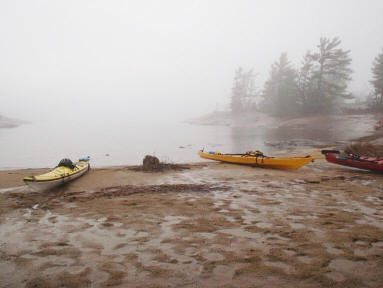Andrew Lawrence
A few brave souls decided to bring in the 2009 paddling season by being on the water as January 1st rolled in. I was not among them. The thought of paddling in icy waters did not appeal to me at the time. However, I did join a trip on the weekend of April 24-26. This trip, led by Gerry Croney, involved two days of kayaking and camping at Honeymoon Bay at the north end of Beausoleil Island.

On Friday, the weather conditions were great. However, early the next morning we were wakened to what seemed like the sound of a supersonic jet flying ten feet over the water or perhaps it was an ocean liner docking in our little bay. It didn’t take long for us to realize that the true source of the sound was in fact a pounding hailstorm, which tested the durability of our camping gear greatly. The hail passed and we gathered on the beach to inspect the icy remains while enjoying breakfast. We soon packed up and headed out for a day paddle.
Fortunately, the skies cleared and we were able to paddle without mishap. There was a great sense of camaraderie and we often paddled as a tight-knit group in order to join in the conversation. The weather was mild and it was easy to keep warm by paddling. In fact, Gerry became overheated and periodically did an Eskimo roll to cool off. I just looked on with a combination of envy and admiration for his skill. However, the water was too cold to lure me in for a “refreshing dip,” particularly given that I only had a wet suit on, whereas Gerry was wearing a dry suit.
We headed back to camp later in the afternoon only to be greeted by a steady downpour of rain. However, since we were at Beausoleil Island, we were able to make use of the large pavilion shelter there to stay dry and we kept warm by building a fire in the pavilion’s fireplace. Most of the group were busy preparing supper but we noticed that Gerry wasn’t. Instead he just stayed close to the fire and sipped on warm drinks.
It was at that point that I wondered whether mild hypothermia was the cause. While dry suits can keep you dry, they do not necessarily keep you warm. I was concerned that perhaps the Eskimo rolls had been enough to drop his core body temperature. Fortunately, the key signs of mild hypothermia (shivering, stiff muscles, cramps, decreased coordination, uncharacteristic behaviour or pale skin) were not present and as the evening progressed, I realized that he was doing all the right things to get warm and was going to be fine.
On Sunday the group enjoyed paddling some more and parted company after enjoying lunch at a local truck stop diner. The camaraderie continued in the following days thanks to internet technology and the sharing of pictures from digital cameras. It was a great trip and I look forward to joining Gerry and the rest of the group for additional kayak trips this summer if possible.
I was glad that there were no mishaps despite the paddle occurring quite early in the season. However, I did make a point of learning more about hypothermia when I got home to ensure that I would know what to do in the future if I ever had to help a fellow paddler. I found out that the most important things to do include: finding shelter out of the wind, lighting a fire or stove, ensuring the paddler is kept dry, wearing layers of dry clothes including a hat, and encouraging the person to drink warm sweet liquids. A surprising fact I learned was that it is sometimes better to allow someone to shiver (as long as they are kept dry) as this is one way to increase the body core temperature. I plan to continue learning more about wilderness first aid this year because you never know when those skills may be called upon.
